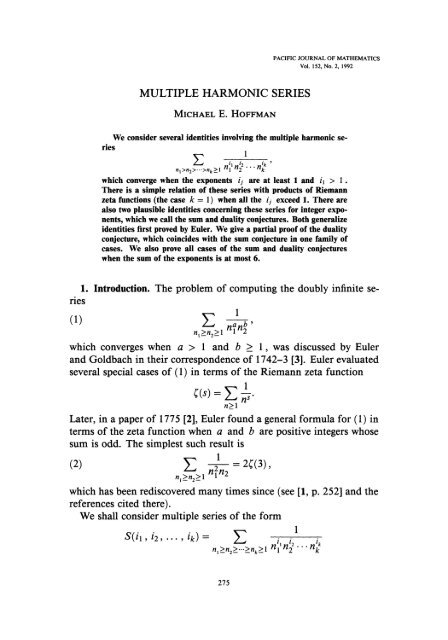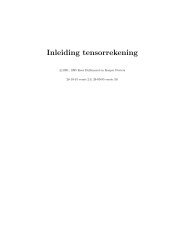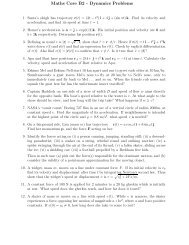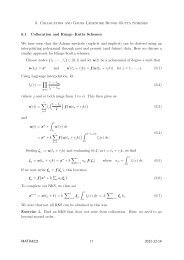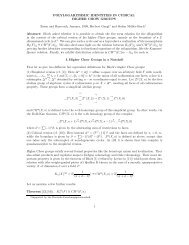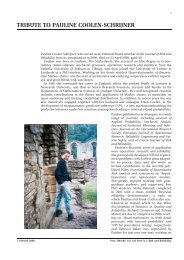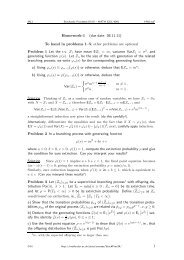View PDF - Project Euclid
View PDF - Project Euclid
View PDF - Project Euclid
You also want an ePaper? Increase the reach of your titles
YUMPU automatically turns print PDFs into web optimized ePapers that Google loves.
MULTIPLE HARMONIC SERIES<br />
MICHAEL E. HOFFMAN<br />
PACIFIC JOURNAL OF MATHEMATICS<br />
Vol. 152, No. 2, 1992<br />
We consider several identities involving the multiple harmonic series<br />
v^ 1<br />
" ii 1 ' 1 #t' 2 n ik '<br />
n ι>n 2>->n k>l n \ n 2 n k<br />
which converge when the exponents /, are at least 1 and i\ > 1.<br />
There is a simple relation of these series with products of Riemann<br />
zeta functions (the case k = 1) when all the i } exceed 1. There are<br />
also two plausible identities concerning these series for integer exponents,<br />
which we call the sum and duality conjectures. Both generalize<br />
identities first proved by Euler. We give a partial proof of the duality<br />
conjecture, which coincides with the sum conjecture in one family of<br />
cases. We also prove all cases of the sum and duality conjectures<br />
when the sum of the exponents is at most 6.<br />
1. Introduction. The problem of computing the doubly infinite series<br />
(1)<br />
Σ τL<br />
n x >n 2 >\ 1 2<br />
which converges when a > 1 and b > 1, was discussed by Euler<br />
and Goldbach in their correspondence of 1742-3 [3]. Euler evaluated<br />
several special cases of (1) in terms of the Riemann zeta function<br />
1<br />
n>\<br />
Later, in a paper of 1775 [2], Euler found a general formula for (1) in<br />
terms of the zeta function when a and b are positive integers whose<br />
sum is odd. The simplest such result is<br />
Σ τhr =<br />
which has been rediscovered many times since (see [1, p. 252] and the<br />
references cited there).<br />
We shall consider multiple series of the form<br />
275<br />
n<br />
\ n<br />
{ ' " n<br />
k
276 MICHAEL HOFFMAN<br />
and<br />
l'l,Ϊ2,. • • , / * ) =<br />
(so (1) is S(α, ft)). With this notation, S(i) = Λ(ι) = £(/). The<br />
relation between the S 's and A's should be clear: for example,<br />
and<br />
S(i\, i 2 ) =<br />
S(i\ , 12 , *3) = -4(ίl > *2 > k) + Λ(l'i + h , h)<br />
+ A(iΪ9 i2 + i3) + A(iι + i2 + i3 ).<br />
Note that (2) implies ,4(2, 1) = C(3).<br />
It is immediate from the definitions that<br />
5(11, h)+s(i 2 , ii) = c(ίoc(/2) + c(/i + ω<br />
and<br />
A(h , I2 ) +^(/2, I'l) = C(/l)ί(l2) - C(/l + 12)<br />
whenever i\, i^> 1. More generally, if ίi, iι, ... , i^ > 1 the sums<br />
Σ ^(ίσίl) J » ίσ(ik))<br />
σ€Σ k<br />
a n d<br />
is the symmetric group of degree fc) can be expressed in terms<br />
of the zeta function. We state and prove such formulas in §2.<br />
There are also two interesting general conjectures about the quantities<br />
A(i\, ... , ίfc) for positive integer exponents i\, ... , i k , which<br />
we call the sum and duality conjectures. Both generalize the identity<br />
A(2, 1) = -4(3). We state them in §3, and give a partial proof of the<br />
duality conjecture in §4. Further evidence for the two conjectures is<br />
discussed in §5.<br />
2. Symmetric sums in terms of the zeta function. To state our results<br />
we shall require some notation. For a partition Π = {P\, P 2 , ... , P/}<br />
of the set {1, 2, ... , k}, let<br />
c(Π) = (cardΛ - l)!(cardP 2 - 1)! (cardP/ - 1)!.<br />
Also, given such a Π and a λ>tuρle i = {i\, ... , i k } of exponents,<br />
define<br />
5=1
MULTIPLE HARMONIC SERIES 277<br />
THEOREM 2.1. For any real i\, ... , /*. > 1,<br />
(1) J>(/ σ(i),...,/ σW)= Σ c(Π)C(i,Π).<br />
partitions Π of {1,..., k}<br />
Proof. Assume that the ij are all distinct. (There is no loss of<br />
generality, since we can take limits.) The left-hand side of (1) can be<br />
written<br />
y y -————<br />
σ n χ >:.>n k >\ n<br />
σ (\)n<br />
σ (2)<br />
n<br />
σ {k)<br />
Now think of the symmetric group Σ^ as acting on /c-tuples (n\, ... ,<br />
n k) of positive integers. A given k -tuple n=(«i,...,Jifc) has an<br />
isotropy group Σ^(n) and an associated partition Λof {1,2,...,/:}:<br />
Λ is the set of equivalence classes of the relation given by / ~ j iff<br />
m = Πj, and Σfc(n) = {σ e Σ k | σ(i) ~ i V/}. Now the term<br />
(2) •„!<br />
\ n<br />
2<br />
occurs on the left-hand side of (1) exactly cardΣ^(n) times. It occurs<br />
on the right-hand side in those terms corresponding to partitions Π<br />
that are refinements of Λ: letting >: denote refinement, (2) occurs<br />
times. Thus, the conclusion will follow if<br />
cardΣ^(n) = ]Γ c{U)<br />
for any k-tuple n and associated partition Λ. To see this, note that<br />
c(Π) counts the permutations having cycle-type specified by Π: since<br />
any element of Σ^(n) has a unique cycle-type specified by a partition<br />
that refines Λ, the result follows.<br />
For k — 3, the theorem says<br />
= ζ(h)ζ(ii)ζ(h) + C(ιΊ<br />
+ ζ(h + h)ζ(h) + 2ζ(i x + h + 13)<br />
for i\, i 2 , h > 1. This is the main result of [7].
278 MICHAEL HOFFMAN<br />
To state the analog of 2.1 for the A % we require one more bit of<br />
notation. For a partition Π = {P\, ... , P[} of {1, 2, ... , k}, let<br />
THEOREM 2.2. For any real i\, ... , i^ > 1,<br />
σGΣ fe<br />
partitions Π of {1,..., k]<br />
Proof. We follow the same line of argument as in the preceding<br />
proof. The left-hand side is now<br />
σ n x >n 2 >-'>n k >\ n σ(l) n σ(2) n σ(k)<br />
and a term (2) occurs on the left-hand side once if all the rti are<br />
distinct, and not at all otherwise. Thus, it suffices to show<br />
(3) Γc(Π) (<br />
w ;£-! I 0, otherwise.<br />
To prove this, note first that the sign of c(Π) is positive if the permutations<br />
of cycle-type Π are even, and negative if they are odd: thus,<br />
the left-hand side of (3) is the signed sum of the number of even and<br />
odd permutations in the isotropy group Σ k (ή). But such an isotropy<br />
group has equal numbers of even and odd permutations unless it is<br />
trivial, i.e. unless the associated partition Λ is {{1}, {2}, ... , {k}}.<br />
When all the exponents are 2 we have the following result, which<br />
proves a conjecture of C. Moen.<br />
COROLLARY 2.3. For k > 1,<br />
Proof. Applying Theorem 2.2, we obtain<br />
i k<br />
π 2k<br />
1=1 partitions {P χ ,...,/>,} of {!,...,*:}<br />
x JJ(cardP 5 - l)!C(2cardP 5).<br />
5=1
MULTIPLE HARMONIC SERIES 279<br />
Using the well-known formula for values of the zeta function at even<br />
integers in terms of Bernoulli numbers (see, e.g., [4]), and writing p s<br />
for card P s, we can express the right-hand side as<br />
/=! partitions {j* ,...,/>} of {!,...,£}<br />
fc π 11<br />
22k-iπ2k π<br />
/=1 partitions {/>,,...,/>,} of {!,...,*} i=l<br />
since the sum of the p s is k. Now for a given (unordered) sequence<br />
/?i, ... , Pi, the number of partitions {P\, ... , P t } of {\, ... , k}<br />
with card Pj = p s for 1 < J < / is<br />
1 f c !<br />
\\m 2 \ • • wι k \p\\p 2 \ • • • P[\'<br />
where m ; = card{s \ p s = /}. Thus, we can rewrite the sum as<br />
{2π) 2k<br />
^ 1 -^ fc! ' '<br />
Ps\(2p s )\<br />
Bin<br />
m λ \- m k\ \22\J m "\<br />
It is then enough to prove the following proposition.<br />
PROPOSITION 2.4. If B n denotes the nth Bernoulli number, then for<br />
k> 1<br />
Proof. Define<br />
k=\<br />
B 2k<br />
Blk<br />
m L
280 MICHAEL HOFFMAN<br />
If we also let<br />
/ih/2\ f<br />
then β(x) = f{x) since β(0) = /(0) = 0 and<br />
x \ \ x<br />
BnX " 1 ( x<br />
(2fc)! χ t ? Γ<br />
K, — 1 ϊl—A<br />
1 1 1 e x<br />
1 1<br />
e x -l x 2 e x -\ x 2 J v J '<br />
(Here we have used the generating function for the Bernoulli numbers.)<br />
Thus<br />
__ sinhx/2 β, x^<br />
-lj! = JC/2<br />
= e<br />
l\ V 22! 44!<br />
Using the multinomial theorem, expand out the right-hand side to<br />
obtain<br />
fl<br />
2k(2k)\<br />
Σ<br />
k=0 m ι +2m 2 +-+km k =k<br />
«(^Γ-G<br />
B<br />
2k \ k<br />
K2k{2k)\ 4<br />
and the conclusion follows by equating coefficients of x 2k<br />
in (4).<br />
3. The sum and duality conjectures. We first state the sum conjecture,<br />
which is due to C. Moen [5].<br />
Sum conjecture. For positive integers k < n,<br />
i x>\<br />
where the sum is extended over /^-tuples i\, ... , i k of positive integers<br />
with i\ > 1.
MULTIPLE HARMONIC SERIES 281<br />
Three remarks concerning this conjecture are in order. First, it<br />
implies<br />
as we prove below. Second, in the case k = 2 it says that<br />
A(n - 1, 1) + A(n - 2, 2) + + A(l, n - 2) = ζ(n),<br />
or, using the relation between the A's and S"s and Theorem 2.1,<br />
n-2<br />
2S{n - l, l) = ( Λ + l)ζ(n) - £ C(*)C(* - *).<br />
A:=2<br />
This was proved in Euler's paper [2] and has been rediscovered several<br />
times, in particular by Williams [8]. Finally, C. Moen [5] has proved<br />
the sum conjecture for k = 3 by lengthy but elementary arguments.<br />
For the duality conjecture, we first define an involution τ on the<br />
set 6 of finite sequences of positive integers whose first element is<br />
greater than 1. Let 3 be the set of strictly increasing finite sequences<br />
of positive integers, and let Σ: 6 —• 3 be the function that sends<br />
a sequence in β to its sequence of partial sums. If 3 n is the set<br />
of sequences in 3 whose last element is at most n, we have two<br />
commuting involutions R n and C n on 3 n defined by<br />
and<br />
C n (a\ 9 ... , afi = complement of {a\, ... , α/}<br />
in {1,2, ...,«} arranged in increasing order.<br />
Then our definition of τ is<br />
τ(J) = Σ- ι<br />
RnCnΣ(I) = Σ- ι<br />
CnRnΣ(I) for / = (z'i, i 2, ... , ik) £ © with iχ-\ h i k = n . (The reader may<br />
verify that τ(7) is actually in 6, has length n-k, and its elements<br />
have sum n .) For example,<br />
τ(3, 4,1) =Σ- 1<br />
C Λ (3, 7, 8)<br />
8 8<br />
= Σ- 1<br />
(3,4,5,7,8) = (3,1, 1,2,1).<br />
We shall say the sequences (i\ 9 ... , i^) and τ(i\, ... , i^) are dual to<br />
each other, and refer to a sequence fixed by τ as self-dual.
282 MICHAEL HOFFMAN<br />
Now we can state our second conjecture.<br />
Duality conjecture. If {h\, ... , h n _ k ) is dual to (i\, ..., i k ), then<br />
A(h Ϊ9 ..., A Λ ^)=^(ii, ...,/*).<br />
We include some remarks on how τ may be more easily computed.<br />
The set 6 is a semigroup under the operation given by concatenation,<br />
and the indecomposables are evidently sequences of the form<br />
(A + 1, 1, ... , 1) with A > 1. It is easily computed that<br />
(2) τ(A + 1, ^1,- :.,1J = (k + 1, J,. ;. , 1><br />
k-\ h-\<br />
(In particular, the duality conjecture implies<br />
Λ-2<br />
for integer n>2. Note that this is also the sum conjecture for the case<br />
k = n - 1. This case follows from Theorem 4.4 below.) Together with<br />
the following proposition, (2) gives an effective method for computing<br />
τ(/) for any / e &.<br />
PROPOSITION 3.1. For I x,I 2eβ, τ(I xI 2) = τ{I 2)τ{I x).<br />
Proof. By induction on the number of indecomposables in I 2 we<br />
can reduce to the case where I 2 is indecomposable. So let<br />
h = (h , , ik) > h = (A + 1, 1,..., 1),<br />
Then<br />
n = i x H h / fc, m = n + h + l.<br />
= Σ'^Λίi!, /i + i 2, ... , /i + + i k, n + A + 1,<br />
rt + A + 2, ... , n + h + l)<br />
, c 2 - c\, ... , c n__ k - c n_ k_ι),
MULTIPLE HARMONIC SERIES 283<br />
where C n R n Σ(I\) = (c\ , C2, ... , c n -k) * from which the conclusion<br />
follows.<br />
We close this section by proving that the sum conjecture implies<br />
(1). We first note that β has a partial order given by refinement, e.g.<br />
(2, 1, 2) and (3, 1, 1) both refine (3,2). Further, S(iχ , ... , ik) is<br />
the sum of those A(j\ 9 ... , j)) for which (iχ 9 ... , i k ) is a refinement<br />
of C/i 9 9 Ji) Thus the sum<br />
ι { -\<br />
can be written as a sum of terms A(j\, ... , j)), each of which appears<br />
with multiplicity<br />
card{(/i, ... , i k)\h > 1 and (iΊ , ... , i k) refines (j x, ... , 7/)}<br />
The equality can be seen combinatorially: think of an ordered sum<br />
i\ H h z^ = n that refines 7Ί H \- Jι = n as defined by choosing<br />
/c - / division points (in addition to those defining the first sum) out<br />
of n - / - 1 possibilities. Thus<br />
Assuming the sum conjecture, the latter sum is<br />
4. Partial proof of the duality conjecture. We shall prove the duality<br />
conjecture for sequences (iχ 9 1, ... , 1) with i\ > 1. We use the<br />
following theorem of L. J. Mordell [6].<br />
THEOREM 4.1 (Mordell). For positive integer k and any a> —k,<br />
y ! = fc ,f (-»' (a-i\<br />
» » > , Λ<br />
i»2 »*(»i +••• + »* + «) " ^jί /!(/ + 1)*+* \ i J'<br />
t h ^ 1 ί<br />
From this we deduce the following result.
284 MICHAEL HOFFMAN<br />
COROLLARY 4.2. For integer h > 1,<br />
= k\A(k+ί, 1,..., 1).<br />
Proof. Differentiate MordelΓs formula p times with respect to a<br />
to get<br />
i=p ^ ' '<br />
Now set a = 0 to obtain<br />
'''<br />
+ Hk<br />
from which the conclusion follows by setting h = p + 1.<br />
On the other hand, we can use the following rearrangement lemma<br />
for multiple series to rewrite the left-hand side of 4.2 another way.<br />
LEMMA 4.3. Let f be a symmetric function in k variables. Then<br />
provided the sums converge.<br />
Proof. We proceed by induction on k. The result is immediate for
k = 1. Now assume it for k and consider<br />
Σ<br />
MULTIPLE HARMONIC SERIES 285<br />
- Σ<br />
1 ' **' ' A: —<br />
Λ *+i = 1<br />
(k +1 )!/(ni,..., n k+ι)<br />
1 + +<br />
where / is symmetric in k + 1 variables. Since the function<br />
^ (k+l)f(n lt ...,n k+ί )<br />
„ _, "1+ ••• + »*+!<br />
is symmetric in /ίi,... 5 ^,we can apply the induction hypothesis<br />
to transform the right-hand side of (1) into<br />
Let 5" be this sum divided by k + 1. Then<br />
n ι ,...,n k+i >l<br />
= Σ<br />
_ v^<br />
f(n Ϊ9 ... , n k + λ )<br />
00<br />
1 \^ f(n\,..., n k+ι)(nι + • • + n k)<br />
By permuting the variables, we see that each of the k terms in the
286 MICHAEL HOFFMAN<br />
latter summation is just S. Thus, the sum is kS and we have<br />
Σ<br />
n,, ,n t+l>l<br />
/(/ii, ... , n k+{) _ ί U<br />
{k+\)\f{n x ,...,n k+ϊ )<br />
••(«i + + «fc+i)'<br />
Applying the lemma with f{n\,... , n k ) = {π\ H 1- n k )~ h gives<br />
fc-l », , ,« t >l<br />
1 τ^ 1<br />
Putting this together with Corollary 4.2, we have<br />
THEOREM 4.4. For integers h, k > 1,<br />
A(h + 1, 1,. ; . , lj =<br />
Λ:—1 Λ-l<br />
From the remarks in §3, Theorem 4.4 is just the duality conjecture<br />
for indecomposable sequences of 6.<br />
5. Evidence for the conjectures. For the computations of this section,<br />
the following result will be useful.<br />
THEOREM 5.1. Let i\, i 2, ... , ik be any sequence of positive integers<br />
with i\ > 1. Then<br />
k<br />
i-2<br />
Σ A<br />
(ii,<br />
\
MULTIPLE HARMONIC SERIES 287<br />
where we write s r for n\ + h n r . But the right-hand side of (1)<br />
can be written<br />
LI<br />
and by a standard partial-fractions identity we have<br />
or<br />
Thus, (2) can be rewritten as<br />
Σ<br />
1 = 1 ψ 1<br />
l4' Λ *+l f ί 0 ^ +1 7=0 4'7<br />
i,-2 ,<br />
+ Y. Σ — - —'<br />
^—' 2 ^—' Z £ l k-\ l 2 7 + 1 Z l~^<br />
7 jj j£_j_i_ 1 ^1 /^— 1 /C rC~rl<br />
or, since the first sum is unchanged by permuting n^ and n^+i ?<br />
Σ<br />
1<br />
' +l 7=0<br />
Now we use the partial-fractions expansion<br />
to obtain<br />
n ι ,...,n k+i >lS 1 S 2<br />
1<br />
S k _<br />
- Σ •••h^k-iψk+ί<br />
7=0
288 MICHAEL HOFFMAN<br />
Continuing in this way, we conclude that (2) equals<br />
7=0<br />
i x - j 9 j + i 9 i 2 9 m m . 9 i k )<br />
7=0<br />
7=0<br />
and since the last sum is A(i\, ... , /^, 1) the conclusion follows by<br />
substitution for (2) on the right-hand side of (1) and appropriate cancellation.<br />
Note that by taking k = 1 in Theorem 5.1 we get<br />
which is just the sum conjecture for two arguments. Recall that the<br />
sum conjecture for n - 1 arguments (where n is the sum of the arguments)<br />
follows from Theorem 4.4: using this together with Theorem<br />
5.1 applied to the sequence<br />
Λ-3<br />
we get the sum conjecture for n - 2 arguments.<br />
Now we consider relations among the quantities A(iχ, ... , i k ) with<br />
n = i\ + -- + ik
MULTIPLE HARMONIC SERIES 289<br />
so A(2, 3) = A(2, 1, 2) (an instance of the duality conjecture). Now<br />
Λ(3, 1, 1) = A(4, 1) by Theorem 4.4, so A(2,2,l) = A(3, 2) from<br />
(3) and all instances of the duality conjecture hold in this case.<br />
For n = 6, we get the sum conjecture immediately for k = 2, 4, 5.<br />
Theorem 5.1 applied to the sequences (4, 1), (3,2), and (2, 3) gives<br />
respectively<br />
(4) A(5, l) + A(4,2) = A(4,l,l) + A(3,2, 1) + A(2,3, 1)<br />
(5) A(4,2) + A(3,3) = A(3, 1, 2) + A(2, 2, 2) +A{3, 2, 1)<br />
(6) A(3, 3) +A(2, 4) = A(2, 1, 3) +A(2, 3, ί) + A(2,2,2).<br />
On the other hand, 5.1 applied to the sequences (3, 1, 1), (2,2, 1),<br />
and (2, 1,2) give<br />
(7) A(4,l,l) + A(3,2,l)+A(3,l,2)<br />
= A(3, 1, 1, l)+A(2,2, 1, 1)<br />
(8) A(3,2, l) + A(2,3,ί) + A(2,2,2)<br />
= A(2,l,2,l) + A(2,2,l, 1)<br />
(9) A(3,l,2)+A(2,2,2) + A(2,l,3)<br />
= A(2, l,l,2)+A(2, 1,2,1)<br />
respectively. Since we know the sum conjecture holds for k = 2 and<br />
k = 4 in this case, the sum of the left-hand sides of (4) and (6) is<br />
C(6), as is the sum of the right-hand sides of (7) and (9). Thus<br />
or A(2, 3,1) = A(3, 1,2), an instance of the duality conjecture.<br />
(Note that all other sequences of length 3 are self-dual.) Using this<br />
fact, we can add equations (4) and (6) to get the sum conjecture for<br />
k = 3. Also, we can conclude from (4) and (7) that<br />
A(5, l) + A(4,2) = A(3, 1, 1, 1) + A{2, 2, 1, 1).<br />
But A(5, 1) = A(3, 1, 1, 1) from Theorem 4.4, so this means A(4, 2)<br />
= A{2, 2, 1, 1). Now we can use (5) and (8) to conclude similarly<br />
that A{3, 3) = A(2, 1, 2, 1), and finally (6) and (9) to get A(2, 4) =<br />
A{2, 1, 1,2). Thus all instances of both conjectures are true when<br />
n = 6.
290 MICHAEL HOFFMAN<br />
REFERENCES<br />
[1] Bruce C. Berndt, Ramanujarΐs Notebooks, Part I, Springer-Verlag, New York,<br />
1985.<br />
[2] L. Euler, Medίtationes circa singulare serierum genus, Novi Comm. Acad. Sci.<br />
Petropol, 20 (1775), 140-186. Reprinted in "Opera Omnia", ser. I, vol. 15,<br />
B. G. Teubner, Berlin, 1927, pp. 217-267.<br />
[3] P. H. Fuss (ed.), Correspondence Mathematique et Physique de quelques cέlebres<br />
Gέometres (Tome 1), St. Petersburg, 1843.<br />
[4] K. Ireland and M. Rosen, A Classical Introduction to Modern Number Theory,<br />
Springer-Verlag, New York, 1982. Chap. 15.<br />
[5] C. Moen, Sums of multiple series, preprint.<br />
[6] L. J. Mordell, On the evaluation of some multiple series, J. London Math. Soc,<br />
33 (1958), 368-371.<br />
[7] R. Sita Ramachandra Rao and M. V. Subbarao, Transformation formulae for<br />
multiple series, Pacific J. Math., 113 (1984), 471-479.<br />
[8] G. T. Williams, A new method of evaluating ζ(2n), Amer. Math. Monthly, 60<br />
(1953), 19-25.<br />
Received May 1, 1990 and in revised form March 29, 1991. The author was partially<br />
supported by a grant from the Naval Academy Research Council. He also thanks<br />
his colleague Courtney Moen for introducing him to the subject of this paper and<br />
discussing it with him.<br />
U. S. NAVAL ACADEMY<br />
ANNAPOLIS, MD 21402


